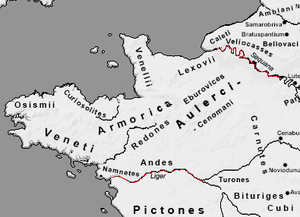Andes (Andecavi)

The Andecavi (also Andicavi[1]) or Andegavi, also Andes in Julius Caesar's Bellum Gallicum, were a people of ancient and medieval Aremorica. They gave their name to the comté Anjou, called Andegavia in medieval Latin.[2]
Geography
The territory of the Andecavi roughly corresponded with the diocese of Angers, Anjou, in the department Maine-et-Loire in present-day France. Although Caesar locates the Andes “near the Ocean,” they held no coast and were located inland along the Loire river.[3]
Role in Gallic Wars
In Book 3 of the Bellum Gallicum, Caesar says that the Andes provided winterquarters for Publius Crassus after his mission into Armorica, which brought several Gallic polities into relations with Rome.[4] Over the winter of 57–56 BC, the Romans built a fleet on the Loire under the command of Decimus Brutus, presumably in preparation for an invasion of Britannia, but which was instead called into action against the Veneti when Armorican objections were raised.
The Andes, led by Dumnacus, played a significant role in the continuing war against Rome after the defeat of Vercingetorix at Alesia. Dumnacus's efforts are recounted by Aulus Hirtius in his continuation of the Bellum Gallicum (Book 8), which covers the two years of the war after Caesar had declared his mission accomplished. Dumnacus lay siege to Limonum (present-day Poitiers), an oppidum of the Pictones, and engaged without success the Roman relief army under the command of Gaius Caninius Rebilus. When additional Roman forces arrived on the scene, Dumnacus was forced to lift the siege and retreat. The army of the Andes was pursued by the Romans and suffered heavy casualties. In a decisive battle the following day, the Romans killed some 12,000 men. Dumnacus escaped, and when Armorica surrendered, he went into self-imposed exile.[5]
References
- ↑ Orosius 6.8.7.
- ↑ For instance, in the Gesta consulum Andegavorum and Geoffrey of Monmouth's Historia Regum Britanniae. The Count of Anjou was in Latin Comes Andegavorum.
- ↑ Michel Rambaud, C. Iulius Caesar De Bello Gallico, secundus tertiusque libri, text, introduction and commentary (Paris 1965), p. 144, note to 7.2.
- ↑ Caesar, Bellum Gallicum 2.33 and 3.7.
- ↑ Aulus Hirtius, Bellum Gallicum 8.26–31.
